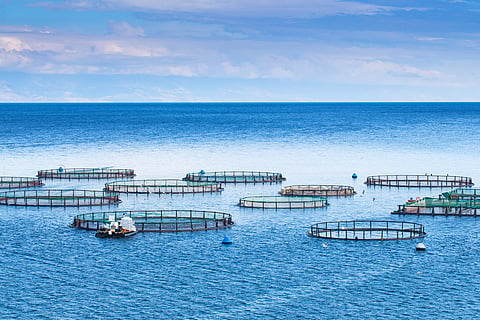

The study explores how enhanced iron sulfide formation could help capture CO2 in aquaculture facilities.
Photo: Adobe Stock.
A groundbreaking model for carbon capture in low-oxygen aquatic environments, such as fish farms, offers a promising, cost-effective solution to combat rising global temperatures, according to a recent study published in the scientific journal Nature Food.
The research, led by Mojtaba Fakhraee, assistant professor of Earth Sciences at the University of Connecticut, and Noah Planavsky, professor of Earth and Planetary Sciences at Yale University, explores how enhanced iron sulfide formation could help capture at least 100 million metric tons of CO2 annually.
This innovative approach aligns with global efforts to meet the Paris Agreement's goal of limiting temperature increases to below 2 degrees Celsius, the researchers say.
“We are in the situation right now that to be able to sustain that 1.5 degree threshold, we should be removing carbon from the atmosphere. There is no way around this point," Fakhraee said in a University of Connecticut news release.
According to its lead author, the study focuses on fish farms because "they are directly influenced by human activities and can be an ideal place for capturing carbon while reducing toxic sulfide concentrations".
The process proposed by the researchers involves introducing iron into low-oxygen aquatic environments. The iron reacts with accumulated hydrogen sulfide, increasing alkalinity and carbonate saturation levels, which enhances the ability of these waters to absorb and store CO2.
The researchers highlight fish farms in countries like China and Indonesia as prime candidates for implementing this model. China alone, with its vast aquaculture industry, could remove nearly 100 million metric tons of CO2 annually using this approach, the researchers say.
Additionally, the model could provide substantial benefits for the aquaculture sector. Hydrogen sulfide, which accumulates in low-oxygen environments, is toxic to fish and contributes to higher mortality rates and reduced profitability. By neutralizing these toxins, the model could support healthier fish populations, enhancing sustainability and economic returns for fish farmers, the researchers argue.
One of the key advantages of this method is its long-term nature, the researchers say. Unlike some carbon capture methods that store CO2 temporarily, Fakhraee claims that carbon captured through this process would remain sequestered for thousands of years.
“It’s going to be stored on a time scale of thousands of years, which is much longer than the lifetime of CO2 in the atmosphere,” he said.
“This is just one possible pathway for carbon capture at a significant scale. The co-benefit for this specific pathway is that it would help with neutralizing the carbon emissions from fish farms resulting in a more sustainable fish industry," Fakhraee stated.
The full research study can be accessed here.
